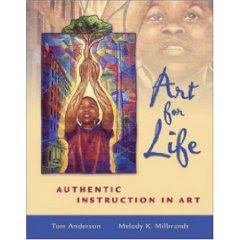- Are interested in new things and are eager to learn, but have short attention spans and are easily fatigued. Stimulate their natural curiosity. Expose them to many manipulative materials and encourage their interest in using art materials.
- Are prolific workers for a short period of time and want to see immediate results. Break lessons into parts, but make sure each part produces a result.
- Can answer speculative questions.
- Can sing songs from memory; can chant and move rhythmically.
- May play alone or cooperatively. The typical developmental sequence is:
- Solitary play (no awareness or interaction with another)
- Onlooker play (near others and aware of their play, but not entering into the other's play)
- Parallel play (independently working on a common activity)
- Associative play (using each other's toys and asking questions)
- Cooperative play (play using differentiated roles)
- Do group projects only when each child can do his/her individual part independently
- Learn social and interpersonal skills while playing. Teach them how to give encouragement to each other about their art
- Like to pretend and engage in make-believe stories about the characters in their pictures.
- Desire the approval of classmates and teachers. Show that you respect their art.
- Have a playful attitude. Can easily interchange between what is real and what is fantasy.
- Can imitate movements of animals. Use movement to motivate art experience.
- Delight in fantasy and imaginative games. Use psychomotor games and role-playing to stimulate art.
- Are developing awareness of their bodies. Use games to encourage children to represent body parts in their artwork.
- Can manipulate object appropriately. Teach the proper way to use a paint brush, markers, and clay, as well as how to clean a table.
- Can spend hours in sand and water play.
- Desire to discover and to test their conceptual and physical powers. Praise students when they have arrived at their "own way" of drawing something.
- Have feelings that are hurt easily. May experience a lack of confidence by determining that another child is the "class artist." Praise individual expression.
- Need outlets for wishes to dominate, destroy, or make a mess.
ARTISTIC DEVELOPMENT
- Drawing development is highly variable
- Children's scribbles or presentations may include:
- Patterns of marking in strokes
- Patterns of dots
- Vertical, horizontal, diagonal, circular, curved, and waving lines
- Placement of patterns on the page, such as overall, quarter page, centered, in halves, along a diagonal axis, and following the shape of a two-cornered arch, a one-corner fan, or a two-corner pyramidal
- They begin to make geometric symbols into their artwork
- They will exaggerate the sizes of things important to them
- They will use non-realistic colors
- May develop an awareness of a ground-line
TEACHING ART
- Kindergartners require little or no motivation from a teacher to create art
- Teacher's role is to encourage and guide individual expression and to help children understand appropriate behaviors in working with art materials
- Help children to be inwardly motivated and to use personal symbols
- Avoid asking questions that may confuse some children or divert their attention
- If children run out of ideas, suggest that they review their past drawings
- While it is important not to dictate creative efforts, teacher must demonstrate how to handle art supplies, finish work appropriately, and reinforce proper classroom behaviors
- Avoid cute, follow-the-directions, gimmicky assembly projects geared to impress parents
- The younger the child, the more attention should be placed on process and less on final product
- Praise the act, not the child
Teaching Drawing-drawing clarifies, focuses, and increases children's comprehension
- Discourage erasing
- Encourage children to perceive and discover
Teaching Painting
- Use 1/2 inch brushes
- If space permits, let children sit on the floor and us 18- by 24-inch paper
- To minimize spills, paint should be the consistency of heavy cream, not water
- Teach children to tap their brushes on jars to control drips
- Use newspapers to control clean-up
Teaching Cutting, Pasting, and Collage
- Have good, working scissors for students to use
- Have a few pairs of left-handed scissors
- Always teach scissors-safety
- Students must be taught how much glue or paste to use and on which surfaces to apply it
- For collage, organize trays or shoeboxes of wallpaper and cloth strips, metal foils and textured papers, feathers, and yarn
Teaching Fingerpainting
- Helps children discover types of lines
- Guide children to use the edge of their hands and their palms as they paint
Teaching with Chalk
- Can be used outdoors on sidewalks or playgrounds
- Water down paper to reduce dust levels or dip into buttermilk while drawing (clean chalk on a screen or on concrete when project is done)
- Use dark colored paper for dramatic effect
Teaching Three-Dimensional Art
- Colored, scented clays may work better with Kindergartners (1 cup of salt, 2-3 cups of flour, and 1 teaspoon of salad oil. Cook in a saucepan on the stove, adding just enough water so that it releases from the sides of the pan.)
- Puppetry helps students overcome shyness and develop public speaking skills
ART CRITICISM, ART HISTORY, AND AESTHETICS
- Art criticism-art talk can deal with what we see, what it is called, how it appears, what colors, shapes, and textures it has in it, and what ideas it brings to mind
- Art history-use art representations to tell stories and let children tell stories, but be careful that children do not feel that their work is insufficient
- Aesthetics-discussions about aesthetics are not beyond kindergartners






No comments:
Post a Comment